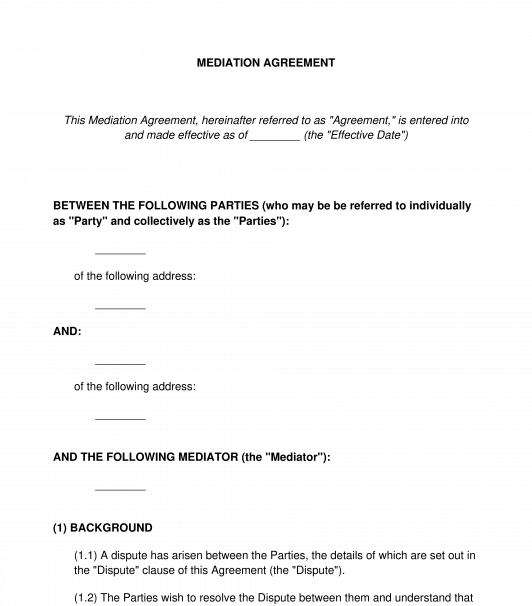 16/08/2025
16/08/2025

Answer a few questions and your document is created automatically.

Your document is ready! You will receive it in Word and PDF formats. You will be able to modify it.

 16/08/2025
16/08/2025
 Word and PDF
Word and PDF
 8 to 11 pages
8 to 11 pages
A Mediation Agreement is a document between two or more parties to a dispute who have decided to try and resolve their dispute without the need for courts, through something called a "mediation." The parties appoint a mediator, who sets up a time to meet with them together and help facilitate a resolution. The Mediation Agreement records the decision that the parties have come to about mediating - including the details of the dispute, details of the mediation, the role of the mediator, how mediation costs will be paid, and confidentiality.
Often, these types of agreements are very helpful to avoid litigation if the parties are able to come to an agreement in the mediation itself.
Even if the parties have not yet reached an agreement about how to resolve the dispute, they may be able to agree that it is worth trying to resolve it through mediation. Mediation has a number of benefits, which are described below.
Mediation in Australia has several benefits, including:
It is also worth remembering that if the parties cannot resolve the dispute at mediation, they still have the option to go to court. And given that the information disclosed during the mediation is not usually admissible in later court proceedings, the parties do not need to fear that a genuine attempt at mediation could jeopardise their position in later court proceedings. Therefore, it is often worth giving mediation a try.
Overall, mediation in Australia is a useful tool for resolving disputes in a timely, cost-effective, and private manner, while allowing the parties to maintain control over the outcome and potentially improve their relationships with each other.
Although it is not mandatory for mediators to possess a qualification to practice in Australia, many mediators choose to undertake training and join an industry scheme. The National Mediator Accreditation System (NMAS) is a nationwide accreditation scheme that establishes a minimum standard for all mediators. Additionally, specialised mediator accreditation programs may coexist with the NMAS, enforcing specific criteria for particular fields like the registration requirements for family dispute resolution practitioners under the Family Law Act 1975. There are various university courses and short courses for mediators in Australia.
Many parties also find it is beneficial to appoint a mediator who has some knowledge about the relevant subject matter. For example, for building disputes, they might choose a mediator who has worked in the construction industry previously.
The law society of each state and territory is often able to recommend mediators in the local area.
Even if the parties have not yet reached an agreement about how to resolve the dispute, they may be able to agree that it is worth trying to resolve it through mediation.
In order to prepare this document, the parties will at least need to agree that they will attend mediation, as well as the details of how the mediation will be run. They may use this document to guide them through some of the important details to consider (such as a time and place for the mediation, the name of the mediator, and how the mediation costs will be paid).
Details about the dispute that led to the need for mediation will be entered in this document along with the parties' identities and basic information.
After this document is filled out, it should be printed out and signed by each party. Additionally, if the dispute arises subject to a contract, attach a copy of the full contract. Then, each party may retain a copy of the Mediation Agreement.
This document can be used for many different types of disputes, including (but not limited to):
While this Mediation Agreement does deal with confidentiality, many parties also like to use our Confidentiality Agreement which addresses the matter in more detail.
Courts in all jurisdictions of Australia have the power to direct parties to attend mediation, even if no party has agreed to mediate. In some cases, there is even an obligation on the parties to attend mediation before coming to court.
The parties, and the mediator are often able to decide at the outset which rules are going to apply to the mediation. Various dispute resolution institutions provide model rules, which the parties are able to adopt. For example, the Australian Centre for International Commercial Arbitratrion has model rules available.
You fill out a form. The document is created before your eyes as you respond to the questions.
At the end, you receive it in Word and PDF formats. You can modify it and reuse it.
A guide to help you: What to do after Preparing a Contract
Mediation Agreement - sample template - Word and PDF
Country: Australia